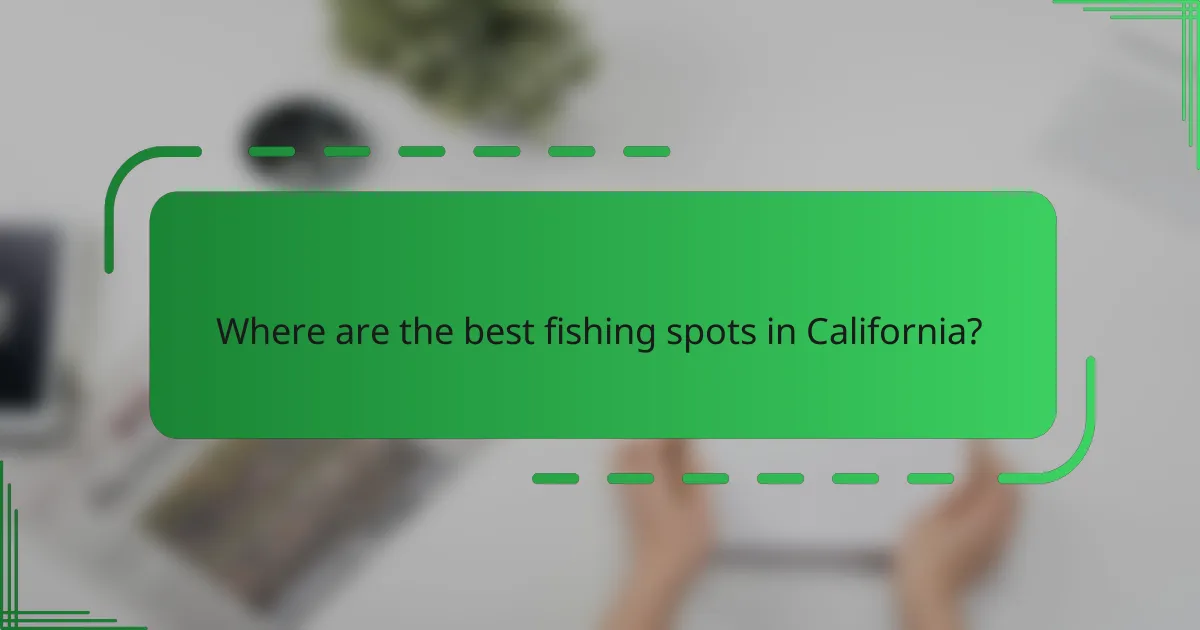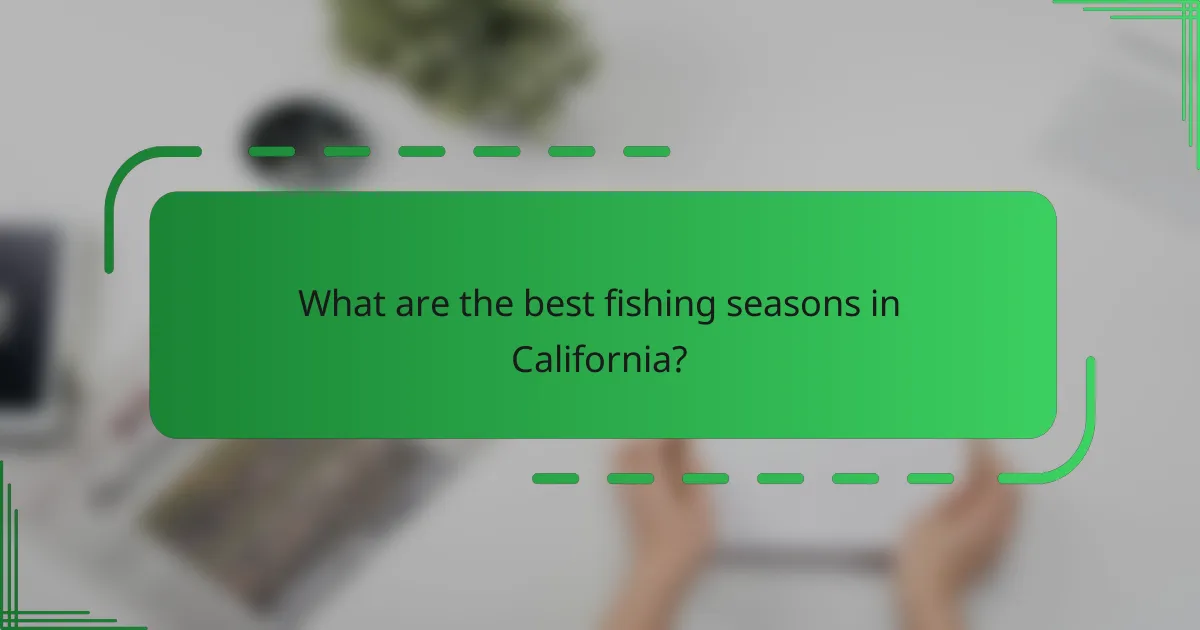California boasts some of the best fishing spots, ranging from serene lakes to vibrant coastal areas, perfect for local anglers. Notable locations like Lake Tahoe and San Francisco Bay offer diverse fishing experiences, catering to various preferences and species, including trout, bass, and salmon. Understanding the habits of these fish and the best seasons for fishing can significantly enhance your success on the water.

Where are the best fishing spots in California?
The best fishing spots in California offer diverse environments, from lakes to coastal areas, catering to various fishing preferences. Popular locations include Lake Tahoe, San Francisco Bay, Mono Lake, Clear Lake, and Shasta Lake, each providing unique fishing experiences and species.
Lake Tahoe
Lake Tahoe is renowned for its crystal-clear waters and stunning scenery, making it a prime fishing destination. Anglers can find species such as mackinaw, rainbow trout, and brown trout, with fishing typically best in spring and fall.
When fishing at Lake Tahoe, consider using a boat to access deeper waters where larger fish reside. Be aware of local regulations regarding fishing licenses and specific rules for certain areas.
San Francisco Bay
San Francisco Bay offers a unique urban fishing experience with access to various species, including striped bass, halibut, and sturgeon. The bay’s diverse habitats, such as piers and marshlands, provide ample fishing opportunities.
Fishing from shore or a boat can yield great results, especially during the summer months. Check local regulations for size limits and seasonal restrictions to ensure compliance.
Mono Lake
Mono Lake is a unique saline lake known for its tufa formations and diverse fish population, including Lahontan cutthroat trout. The fishing season typically runs from April to November, with the best times being early morning or late evening.
Anglers should be prepared for changing weather conditions and bring appropriate gear for both freshwater and saltwater species. A fishing license is required, and it’s essential to follow local guidelines to protect the lake’s ecosystem.
Clear Lake
Clear Lake is California’s largest natural freshwater lake, famous for its bass fishing, particularly largemouth and smallmouth bass. The lake’s warm waters make it an excellent spot for fishing from spring through early fall.
Consider using live bait or lures that mimic local forage to increase your chances of a successful catch. Be mindful of local fishing tournaments, which can affect access to certain areas during peak times.
Shasta Lake
Shasta Lake is a popular destination for anglers seeking a variety of fish, including kokanee salmon, rainbow trout, and bass. The lake’s expansive size and numerous coves provide ample fishing spots throughout the year.
Fishing from a boat is often the most effective method, especially for targeting deeper waters. Always check for current fishing regulations, as they can change seasonally and may include specific limits on certain species.

What types of fish can you catch in local waters?
Local waters offer a diverse range of fish species, including trout, bass, catfish, and salmon. Each type presents unique challenges and rewards for anglers, making it essential to know their habits and habitats for successful fishing.
Trout species
Trout are among the most sought-after fish in local streams and lakes. Common species include rainbow, brown, and brook trout, each thriving in different water conditions. Rainbow trout prefer cooler, well-oxygenated waters, while brown trout are more adaptable and can be found in a variety of environments.
When fishing for trout, consider using light tackle and artificial flies or lures that mimic their natural prey. Early mornings or late afternoons are often the best times to catch them, as they are more active during these periods.
Bass varieties
Bass fishing is popular in many local waters, with largemouth and smallmouth bass being the most common varieties. Largemouth bass are typically found in warmer, shallow waters with plenty of vegetation, while smallmouth bass prefer cooler, rocky environments.
Effective techniques for bass fishing include using topwater lures during dawn and dusk or jigs and soft plastics during the day. Pay attention to seasonal patterns, as bass behavior changes with the water temperature and spawning cycles.
Catfish
Catfish are abundant in many local rivers and lakes, making them a favorite for anglers looking for a hearty catch. Species such as channel catfish and flathead catfish are commonly targeted, with channel catfish being more active during the day and flatheads typically feeding at night.
When targeting catfish, use strong tackle and bait such as cut bait, live bait, or stink bait. Look for them near structures like fallen trees or deep holes, as these areas provide shelter and feeding opportunities.
Salmon
Salmon fishing is a thrilling experience for many anglers, especially during their spawning runs in local rivers. Common species include Chinook and Coho salmon, which can be found in both freshwater and saltwater environments.
To successfully catch salmon, consider using trolling techniques or casting spoons and plugs during their migration periods. Pay attention to local regulations regarding fishing seasons and limits, as these can vary significantly based on the species and location.

What are the best fishing seasons in California?
The best fishing seasons in California vary by species and region, but generally, spring and fall are prime times for many anglers. Each season offers unique opportunities and challenges, making it essential to understand the specific conditions and regulations that apply.
Spring fishing
Spring fishing in California typically runs from March to June, coinciding with the spawning season for many fish species. This is an excellent time to catch bass, trout, and catfish as they become more active in warmer waters.
Anglers should focus on shallow waters and areas with vegetation, as fish tend to move closer to the shore. Using lures that mimic spawning bait can increase your chances of success during this season.
Summer fishing
Summer fishing spans from June to September and is characterized by warmer water temperatures. This is a peak season for saltwater fishing, especially for species like halibut and rockfish along the coast.
During summer, early morning and late evening are the best times to fish, as fish seek cooler water. Consider using live bait or topwater lures to entice strikes during these times.
Fall fishing
Fall fishing occurs from September to November and is often regarded as one of the best times for freshwater fishing. As temperatures drop, fish become more aggressive in preparation for winter, making them easier to catch.
Focus on areas where fish are feeding heavily, such as near schools of baitfish. Techniques like trolling or using jigs can be particularly effective during this season.
Winter fishing
Winter fishing in California lasts from December to February and can be challenging due to colder temperatures. However, some species, like trout and steelhead, can still be caught in rivers and lakes.
During winter, fish tend to be less active, so anglers should fish deeper waters and use slower presentations. It’s essential to dress warmly and be prepared for changing weather conditions while fishing in winter.

What fishing regulations should locals know?
Locals should be aware of fishing regulations that govern licensing, catch limits, and seasonal restrictions to ensure sustainable fishing practices. Understanding these rules helps protect aquatic ecosystems and ensures compliance with local laws.
Licensing requirements
To fish legally, locals must obtain the appropriate fishing license, which varies by state or region. Most areas offer different types of licenses, such as resident, non-resident, and youth licenses, often at varying price points, typically ranging from $10 to $50 USD.
It’s essential to check the local wildlife agency’s website for specific requirements and to ensure that the license is renewed annually. Some locations may also require additional permits for specific types of fishing, like saltwater or freshwater fishing.
Catch limits
Catch limits dictate the maximum number of fish a person can keep in a day, which helps maintain fish populations. These limits can vary significantly based on species, with some common limits being 1-5 fish per day for popular species like bass or trout.
Locals should familiarize themselves with the specific catch limits for their area, as exceeding these limits can result in hefty fines. Always check the latest regulations, as they can change seasonally or annually.
Seasonal restrictions
Seasonal restrictions indicate specific times when fishing certain species is prohibited to protect spawning populations. For example, many regions have closed seasons for bass during their breeding months, typically from late spring to early summer.
Locals should be aware of these restrictions and plan their fishing trips accordingly. Checking local regulations before heading out is crucial, as fishing during closed seasons can lead to penalties and harm to fish populations.

How to choose the right fishing gear?
Selecting the right fishing gear is essential for a successful fishing experience. Consider factors such as the type of fish you are targeting, the fishing environment, and your personal skill level when making your choices.
Rod and reel selection
The rod and reel are fundamental components of your fishing gear. When selecting a rod, consider its length, power, and action, which affect casting distance and sensitivity. A medium-action rod is versatile for various species, while a heavier rod is better for larger fish.
For reels, choose between spinning and baitcasting types based on your comfort and experience. Spinning reels are user-friendly and great for beginners, while baitcasting reels offer better control and are preferred by experienced anglers. Ensure the reel size matches the rod and is suitable for the fish you plan to catch.
Additionally, check the gear ratio of the reel, which affects how quickly you can retrieve your line. A higher gear ratio is beneficial for fast retrieval, while a lower ratio provides more torque for reeling in larger fish. Always test your setup before heading out to ensure everything works smoothly.



